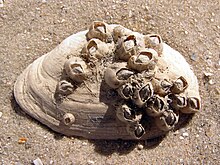 |
 |
| Harpetida Harpes |
Asaphida Cryptolithus |
The last, but not least, evolutionary trend that Sam Gon III is discussing in his website is pitted fringe by which they mean an expansion of the cephalon into a concave chamber.
This Big Head on the two samples shown in the drawings has numerous fenestrations.
Why?
"In both cases the cephalon is the dominant part, with transverse thoracic segments and an unremarkable pygidium. Long genal spines or genal prolongations are also notable in this morphotype. They are thought to help stabilize the trilobite during filter-feeding."
Sam
Filter-feeding brings to my mind for example whales, those lazy bums that just swim around big mouth open and food enters into their system.
But what did these trilobites filter-feed themselves into?
What did trilobites eat?
"Trilobites occupied a huge set of habitats and paleolatitudes, from tropical shallows and reefs, to polar depths, and wide-ranging pelagic habitats in between.
Their diversity of form suggests a complex ecology with many modes of life, including occupation of a variety of trophic (feeding) guilds.
There has been a long history of speculation about the feeding habits of trilobites, ranging from predators, scavengers, filter-feeders, free-swimming planktivores, and even parasites or hosts of chemoautrophic symbionts.
Using modern-day crustaceans as an analog, it is reasonable to suggest that the majority of trilobites may have been predator-scavengers, as the majority of marine crustaceans are today.
Nonetheless, among today's crustaceans are filter-feeders (such as barnacles), planktivores (the majority of larval crustaceans fall into that category), herbivores (many small shrimp species), and parasites (a few copepods, isopods, and other taxa).
Sam
Their diversity of form suggests a complex ecology with many modes of life, including occupation of a variety of trophic (feeding) guilds.
There has been a long history of speculation about the feeding habits of trilobites, ranging from predators, scavengers, filter-feeders, free-swimming planktivores, and even parasites or hosts of chemoautrophic symbionts.
Using modern-day crustaceans as an analog, it is reasonable to suggest that the majority of trilobites may have been predator-scavengers, as the majority of marine crustaceans are today.
Nonetheless, among today's crustaceans are filter-feeders (such as barnacles), planktivores (the majority of larval crustaceans fall into that category), herbivores (many small shrimp species), and parasites (a few copepods, isopods, and other taxa).
Sam
Comment
So my association was not completely off. Professional evolutionary biologists also look at the familiar Nature of modern world and look for analogies.
Of course, my example of whales is far off, but the quote from Sam's expert text gives a listing of closer parallels between today's world and the very first eaters on our planet.
Remarkably interesting!
Barnacle

Balanus improvisus
one of the many barnacle taxa erected by Charles Darwin
wikimedia
As for the analogue of filter-feeding barnacles:
"A barnacle is a type of arthropod belonging to infraclass Cirripedia in the subphylum Crustacea, and is hence related to crabs and lobsters.
Barnacles are exclusively marine, and tend to live in shallow and tidal waters, typically in erosive settings. They are sessile (non-motile) suspension feeders, and have two nektonic (active swimming) larval stages. Around 1,220 barnacle species are currently known.
The name "Cirripedia" is Latin, meaning "curl-footed".
wikipedia
No comments:
Post a Comment